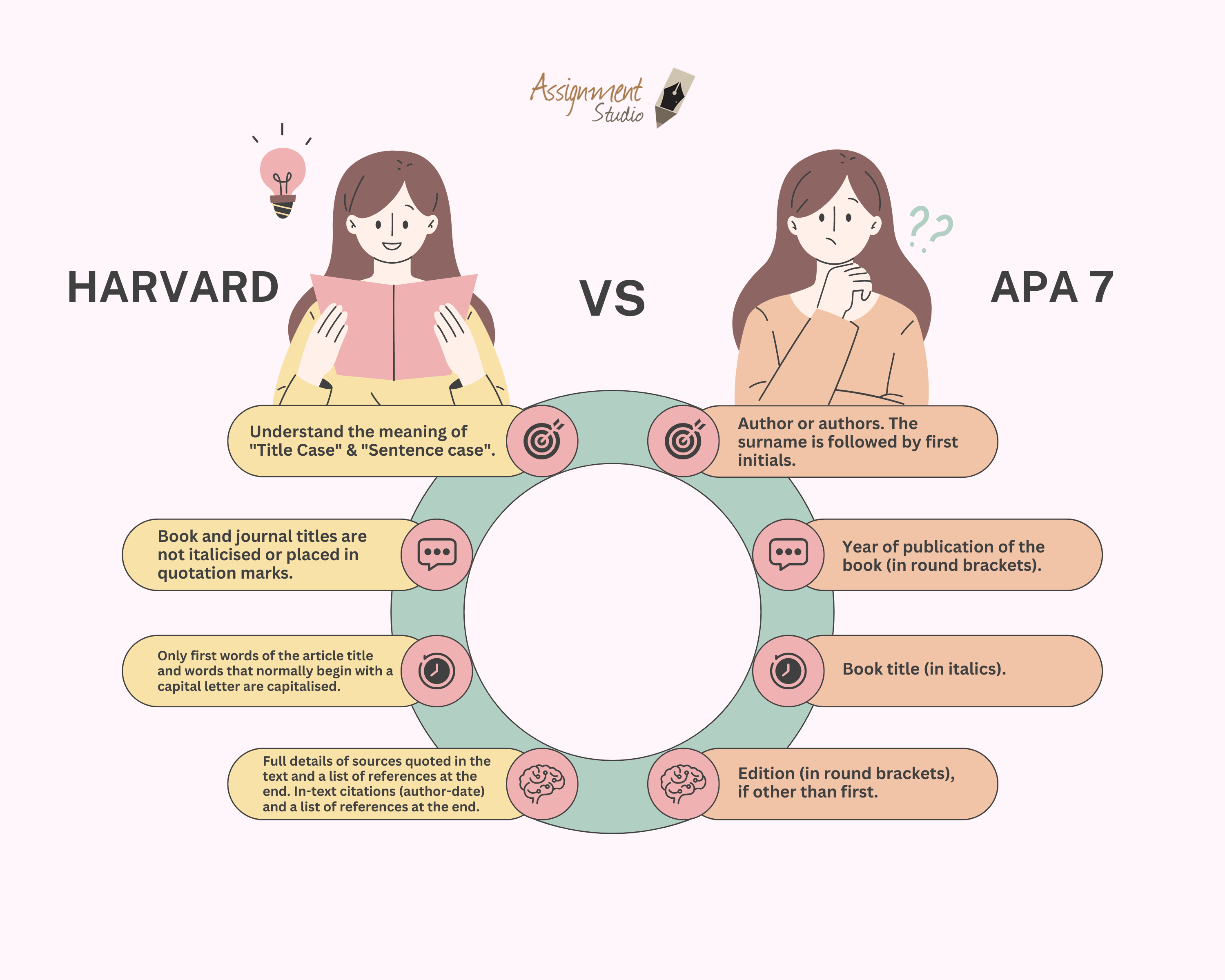
As an Australian student, you know that proper referencing is crucial for academic success. But with so many different referencing styles out there, it can be confusing to keep track of the rules and differences between them. Two of the most common styles you’ll come across are Harvard and APA 7 (the 7th edition of the American Psychological Association’s referencing style).
In this ultimate showdown, we’ll break down the key differences between these two popular referencing styles, so you can master them like a pro and ensure your assignments and research papers are up to par.
But first, let’s define what referencing styles are and why they’re so important for Australian students.
Table of Contents
What are Referencing Styles?
Referencing styles are standardized systems for citing and referencing sources used in academic writing. They provide guidelines for how to format in-text citations and reference lists, ensuring consistency and clarity across different types of sources.
Following the appropriate referencing style is crucial for several reasons:
- Avoiding plagiarism: Properly citing sources gives credit to the original authors and demonstrates academic integrity.
- Credibility: Using a consistent and widely-accepted referencing style adds credibility and professionalism to your work.
- Simplifying the process: Referencing styles provide clear rules, making it easier to cite sources accurately and efficiently.
Now that we understand the importance of referencing styles, let’s dive into the key differences between Harvard and APA 7.
Harvard Referencing Style: The Classic Choice
The Harvard referencing style, also known as the author-date style, is widely used in Australia and other parts of the world, particularly in the humanities and social sciences. Its simplicity and straightforward approach make it a popular choice among Australian students and academics.
Key Features of the Harvard Referencing Style:
- In-text citations: Author’s last name and year of publication are enclosed in parentheses, e.g., (Smith, 2022).
- Reference list: Sources are listed alphabetically by the author’s last name, with the year of publication following the author’s name.
- Source types: Guidelines for citing various source types, including books, journal articles, websites, and more.
- Punctuation and formatting: Specific rules for using punctuation, capitalization, and formatting in reference entries.
Example Reference List Entry (Book):
Smith, J. (2022). The Art of Referencing. Melbourne University Press.
APA 7 Referencing Style: The Scientific Approach
The APA (American Psychological Association) referencing style is widely used in the social sciences, particularly in fields like psychology, education, and nursing. The 7th edition, published in 2020, introduced some significant changes to the previous edition.
Key Features of the APA 7 Referencing Style:
- In-text citations: Author’s last name, year of publication, and page number (for direct quotes) are enclosed in parentheses, e.g., (Smith, 2022, p. 25).
- Reference list: Sources are listed alphabetically by the author’s last name, with the year of publication following the author’s name.
- Source types: Specific guidelines for citing various source types, including books, journal articles, websites, and more.
- DOI (Digital Object Identifier): Emphasis on including DOIs for journal articles and other online sources.
- Formatting: Specific rules for using headings, abbreviations, and formatting in academic papers.
Example Reference List Entry (Journal Article):
Smith, J. (2022). The importance of referencing styles in academic writing. Journal of Academic Studies, 25(3), 123-145. https://doi.org/10.1037/abn0000123
Key Differences Between Harvard and APA 7
Now that we’ve covered the basics of each referencing style, let’s dive into the key differences between Harvard and APA 7.
- In-text citation format:
- Harvard: (Author, Year)
- APA 7: (Author, Year, p. #) for direct quotes
- Reference list order:
- Both styles list sources alphabetically by the author’s last name.
- Punctuation and formatting:
- Harvard uses commas to separate elements in reference entries, while APA 7 uses periods.
- APA 7 has specific guidelines for formatting headings and using abbreviations.
- Source types:
- Both styles have guidelines for citing various types of sources, but the specific formatting may differ.
- DOI inclusion:
- APA 7 emphasizes including DOIs (Digital Object Identifiers) for online sources, while Harvard does not require them.
- Common use:
- Harvard is more commonly used in the humanities and social sciences in Australia.
- APA 7 is more prevalent in the social sciences, particularly in fields like psychology and education.
Mastering Harvard and APA 7 for Australian Students
As an Australian student, mastering both the Harvard and APA 7 referencing styles is essential for academic success. Different courses and disciplines may require you to use one style over the other, so it’s crucial to be familiar with the rules and conventions of each.
Here are some tips to help you master these referencing styles:
- Consult official style guides: Refer to the official manuals or online resources for the most up-to-date guidelines and examples.
- Use referencing tools: Leverage referencing software or online tools like Citavi, Mendeley, or Zotero to streamline the referencing process.
- Attend workshops: Many Australian universities offer workshops or resources to help students understand and apply referencing styles correctly.
- Seek guidance: Don’t hesitate to reach out to your professors, librarians, or writing centers for clarification or assistance with referencing.
- Practice consistently: The more you practice using these referencing styles, the more familiar and comfortable you’ll become with their conventions.
By mastering both the Harvard and APA 7 referencing styles, you’ll not only demonstrate your academic proficiency but also ensure that your assignments and research papers meet the highest standards of quality and credibility.
In the world of academic writing, proper referencing is essential for maintaining integrity and credibility. While the Harvard and APA 7 referencing styles have their similarities, understanding their key differences is crucial for Australian students.
By mastering both styles and applying them consistently in your academic work, you’ll not only avoid plagiarism but also showcase your attention to detail and commitment to scholarly excellence.
So, whether you’re studying at the University of Melbourne, the University of Sydney, or any other top Australian institution, remember to always follow the appropriate referencing style guidelines to ensure your academic success.






